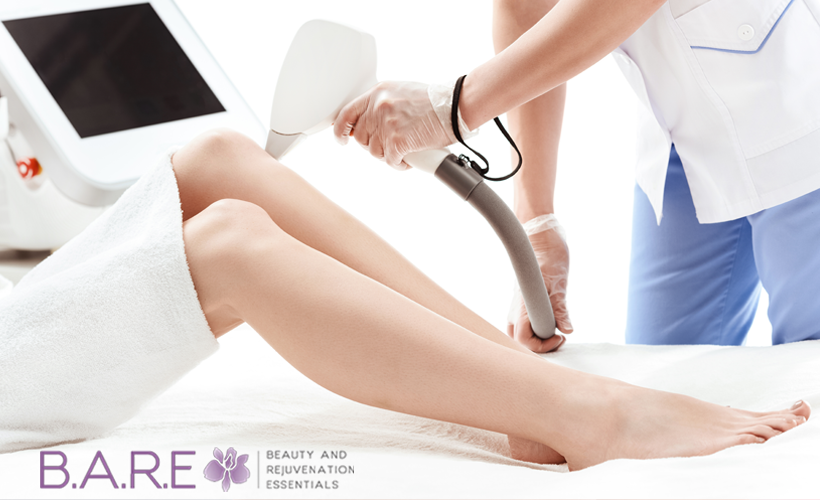
Who doesn’t like smooth skin on your face and body? Men and women alike desires smooth, hairless skin like the tanning models you see in magazines. Body hair affects our self-confidence, social interactions, and choice of clothes in the summer. The good news is, laser hair removal can be an excellent way to get rid of unwanted hair.
How does laser treatment work?
Before you know if laser hair removal treatments are the right choice for you, it’s essential for you to know how it works. During the process of the hair removal treatment, your aesthetic technician will use a hand-held device to project laser beams of a particular wavelength into your skin. The energy from this light heats and damages the hair follicles after getting transferred on to your skin.
It is essential to target the hair follicle roots directly at the base of the hair bulb. The process also involves taking care not to damage melanin in darker skin types. Otherwise, lighter spots may develop for people with darker skin tones. Laser beams are effective for all hair types, be it smooth or coarse hair.
The most common areas for laser hair treatment include upper lips, chin, legs, arms, armpits, bikini line, chest, etc. Laser hair removal clinics can be effective in removing hair in almost all areas of the body except the eyelids. It works better for darker hair colors as brown, black or even red hair absorbs less light.
Will it remove hair permanently?
Laser treatment works in two ways. It either reduces the density of unwanted hair or gives you permanent hair removal. While, In both cases, permanence will be achieved after you have undergone several sessions of laser treatment, the frequency of treatment will not be the same for everyone. The first thing you should know is the difference between density reduction and hair removal.
When your laser treatment leads to a reduction of hair density, some of the hairs will grow back in between sessions. So your laser therapy will be an ongoing process. On the other hand, permanent hair removal means no hair will regrow in the treated area, and no further ongoing treatment will be required to remove hairs further. Whether you’ll experience hair density reduction or permanent hair removal will depend on –
- Hair color and thickness,
- Skin color,
- Contrast between hair color and skin color,
- Skin type and sensitivity,
- Type of laser,
- Competence of the surgeon.
Remember that permanent hair removal cannot be achieved after just a few sessions of laser treatments. It can only happen when you have undergone multiple sessions of the treatment consistently over a few years. This is the only way to expect the light energy to work its magic in the eradication of hair follicles completely to prevent the regrowth of hair.
During several years of regular laser hair treatments, you’ll achieve a permanent reduction of hair density. The treatment must take place under proper supervision to reduce top-up sessions. This needs to go on until you reach permanent hair removal. So, even while though you will need a few years before you can stop laser treatment, the results of each session will be reasonably long-lasting.
How many treatments will I need?
Several factors must be considered for laser treatment. It needs to be performed at the appropriate hair stage growth. The time gap between two re-treatment sessions should be long enough to allow new hair to grow. The total session number will depend on several factors, including your skin color, sun sensitivity, hair color, and whether or not the treatment area is prone to fast hair regrowth.
People with pale skin tend to burn easily but develop tans more slowly. They usually need fewer sessions to achieve permanent hair removal. People with dark skin require more sessions. This principle is reverse when it comes to hair color, i.e., if you have dark hair, you will see great results, while light hair will respond less to laser treatments. You may need 4-12 treatments every 4-15 weeks apart.
What side effects or complications from laser treatment should I be aware of?
During your laser treatment, you’ll expect some pain and discomfort, especially during the first few sessions. This can be reduced a little by shaving properly beforehand to prevent hair strands from absorbing heat. After the treatment, your skin will feel a little hot for about 15-30 min and experience redness and swelling for as long as a day.
If you have sun-tanned or sensitive skin, you may see blisters, scarring, crusting, discoloration, or pigmentation in the hands of incompetent surgeons who cannot adjust the settings of the laser hair removal device properly though it is pretty rare. Medications that affect your skin’s sun sensitivity can also lead to side effects after laser treatment. You can also experience temporary skin irritation.
Does the type of laser matter?
The type of laser has no effect on its impact and result. It can, however, influence the side effects of laser hair treatment. Ruby, Alexandrite, Diode, and Nd:YAG lasers are long pulse lasers ideal for hair removal. However, short laser pulses can help keep the spread of heat under control. This will prevent unnecessary and unwanted damage to the tissues.
Intense Pulsed Light devices can’t be categorized as laser devices. They are flash lamps emitting multiple light wavebands that work like lasers through their effects in achieving permanence is not the same. IPL is recommended for fair skin types, where with darker colours the long pulse lasers are more effective.
To get the best laser treatment, contact BARE Essentials Spa TODAY!

